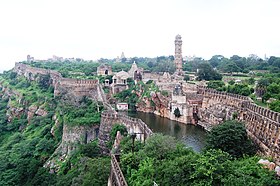
Back चित्तौड़गढ़ की घेराबंदी (१३०३) Hindi चित्तौडगढको पतन (१३०३) Nepali محاصرہ چتوڑگڑھ (1303) PNB Cerco de Chittorgarh (1303) Portuguese சித்தோர்கார் முற்றுகை (1303) Tamil చిత్తోర్గఢ్ ముట్టడి (1303) Tegulu محاصرہ چتوڑگڑھ (1303ء) Urdu
| Siege of Chittorgarh | |||||||||
|---|---|---|---|---|---|---|---|---|---|
| Part of Wars between the Kingdom of Mewar and the Delhi Sultanate | |||||||||
 | |||||||||
| |||||||||
| Belligerents | |||||||||
| Delhi Sultanate | Guhila dynasty | ||||||||
| Commanders and leaders | |||||||||
| Alauddin Khalji |
Ratnasimha Rana Lakhan † Ari Singh †[1] | ||||||||
| Casualties and losses | |||||||||
| Unknown | 3,000 or 30,000 killed[2] | ||||||||
Location of the Siege of Chittorgarh | |||||||||
The siege of Chittorgarh occurred in 1303, when the Khalji ruler Alauddin Khalji (r. 1296–1316) captured and sacked the Chittor Fort, toppling the Guhila king Ratnasimha, after an eight-month-long siege. The conflict has been described in several legendary accounts, including the historical epic poem Padmavat, which claims that Alauddin's motive was to obtain Ratnasimha's beautiful wife Padmini; though this legend is considered of little historically significance by most historians. Alauddin ordered the fort to be pelted with stones from his siege engines (munjaniqs). When the fort was stormed, Rajput women committed Jauhar while most of the warriors died defending the fort. The city of Chittor was completely sacked by Alauddin's army and several temples were desecrated.
- ^ Rima Hooja 2006, p. 313:"Much has been written about the siege, and the bravery of its defenders prominent among who were Rana Lakhan-Si (Lakshmanasimha, or Lakshman Singh) of the Sisoda estate, and his seven sons members of the junior line of the Mewar ruling family"
- ^ Mehta, Jaswant Lal (1979). Advanced Study in the History of Medieval India. Sterling Publishers Pvt. Ltd. p. 149. ISBN 978-81-207-0617-0.

